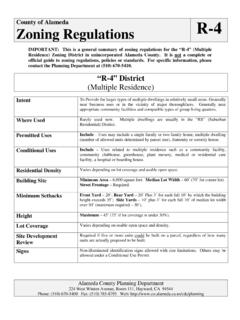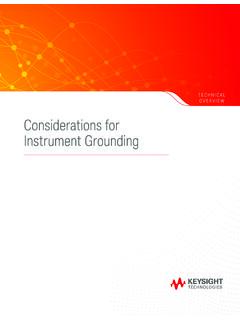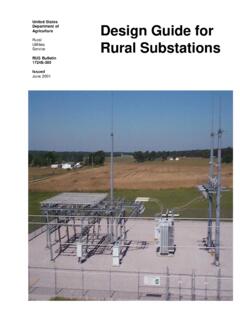Transcription of Guidelines for future Electric Vehicle Charging Stations ...
1 June 2018 1 Guidelines for future Electric Vehicle Charging Stations at Alameda County Facilities Terms: Electric Vehicle Supply Equipment (EVSE): Charging Stations and associated immediate infrastructure ( transformers , etc.) excluding building electrical infrastructure such as electrical panels, conduit/raceways, overprotection devices, wires and pull boxes. Level 2: EVSE that operates on a 40-Amp 208 or 240-volt circuit and provides power between and kW. Direct Current Fast Charger (DCFC): EVSE that provides a minimum of 40 kW of power. Circuit requirements will change with charger power.
2 EV Readiness: Parking structure and parking spots equipped with make-ready infrastructure to support the immediate and convenient installation of an EVSE, including electrical panels, conduit/raceways, overprotection devices, wires and pull boxes. The goal of EV Readiness is to prepare for the future installation of EVSE at minimum cost. EV Capable: Parking structure has the electrical panel capacity to provide EV Charging but not necessarily the complete supporting infrastructure connecting the panels to the EV parking spot. Introduction Pursuant to the California Green Building Standards Code (Title 24, Part 11, Chapter 5), all new construction must provide parking spaces and electrical infrastructure sufficient to support the future installation of Electric Vehicle Supply Equipment (EVSE)1.
3 These Guidelines provide a roadmap, beyond the minimum requirements, for new construction of County facilities that supports and continues the County s role as a regional leader in both the adoption of EVs and the installation of EVSE. GSA Logistics Services is investing in EVSE to transition the County s Vehicle fleet to EVs and should be consulted on new projects. Beyond experience, Logistics Services may also have access to grant or local funds that assist in the expansion of EVSE, thereby reducing project cost. These Guidelines build upon GSA-Logistics Services expertise to expand on specific sections of Title 24 and provide useful details that are left open in existing code.
4 These Guidelines also discuss important additional considerations not addressed in Title 24. Applicability These requirements apply to both new construction and significant renovations that include parking. Any project that involves resurfacing or excavating of a parking lot should be considered a significant renovation . 1 See Appendix A for description of requirements under the California Green Building Standards. June 2018 2 Goals of Guidelines future proof and reduce costs of fleet electrification by ensuring that all necessary Charging infrastructure, such as conduit, is installed in locations that are difficult to access after construction is finished.
5 Establish a system to consult GSA-Logistics throughout the design process to ensure that Guidelines are being met and the existing expertise of County departments is being leveraged. Summary of Guidelines Require that all new County buildings and any significant alterations, at locations with parking, be 100% EV capable and 10% EV Ready. Additionally require that EVSE be installed at the 10% of spots that are EV Ready as a part of the project budget. Provide an outline to allow full Level 2 Charging at 20% of parking spaces or to utilize power management systems to provide lower Level 2 Charging at 100% of parking spaces, constituting 100% EV Capability.
6 Section A - EV Parking Spots Calculation & Framework for Installation 1. While Title 24 provides EV spot requirements and requires only 6% of spots be EV ready for parking lots above 201 spots, Logistics Services recommends that all new parking lots/garages or major renovations at current parking lots/garages should prepare a minimum of 10% of spaces for EV Readiness and the remaining 90% to be EV Capable. Additionally, EVSE should be installed during project construction at the 10% of spots that are EV Ready. Specific requirements can be found in the table below. Total Number of Parking Spaces Number of Required EV Ready Spaces <50 4 >50 10% Note: Number of Required EV Ready spaces should be rounded up to the nearest whole number.
7 2. The cost of the EVSE itself should be included in the project budget, in addition to the cost of making spots EV Ready and EV Capable and GSA-Logistics should be consulted to provide the latest EVSE specifications to guide installation a. In some cases it may make sense for GSA-Logistics to manage the installation of the EVSE itself, using existing relationships with vendors under contract to minimize cost, either during or immediately following construction. Logistics has experience and expertise on what specific charger types and accompanying software is needed for a particular location.
8 3. In cases where installation of EVSE at EV Capable spots is not required at the time of construction, GSA-Logistics will manage installation and cover costs at future date. 4. In cases where meeting EV Readiness requirements is thought to be unreasonable or unnecessary given project specifics, an exemption may be possible after consultation with GSA-Logistics. June 2018 3 Section B - Spot Location 1. EV parking spots should be located in preferred spots near entrances to encourage EV adoption and use. Preferred parking is a common method to incentivize behavior and is used to encourage other behaviors like carpooling.
9 2. Close proximity to electrical panels is another factor to consider because it will reduce the cost of EVSE installation in major remodels. It is less important in the context of new construction. Locating chargers near existing Electric infrastructure reduces cost because it reduces the length of the necessary conduit/raceways, which are particularly expensive to install at existing facilities because they often require tunneling. However, if this conduit/raceway is being installed during construction, as is required by Title 24 and detailed in these Guidelines , then it becomes less important because it is much less expensive.
10 Section C - EV Ready Spots - Raceway, Conduit, and Electrical Plan Requirements & Hardware 10% of total parking spaces 1. To ensure EV Readiness in new buildings or substantial demolition, remodeling or resurfacing projects, the following should be provided for each spot: a. A 40-Amp 208 or 240-volt branch circuit, including raceway/conduit, electrical panel capacity, overprotection devices, wire, and pull boxes. Pull boxes should be located at or near the location of future Charging Stations so that contractors can easily pull wire from the control panels to the Stations without the need to trench or add new conduit.















